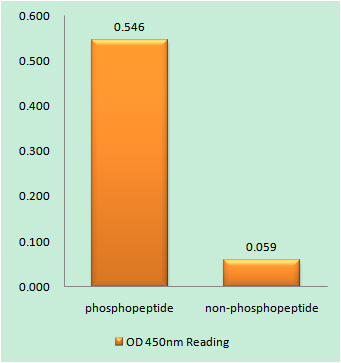
Catalog: YP1151
Size
Price
Status
Qty.
200μL
$600.00
In stock
0
100μL
$340.00
In stock
0
50μL
$190.00
In stock
0
Add to cart


Collected


Collect
Main Information
Target
Vinculin
Host Species
Rabbit
Reactivity
Human, Mouse, Rat
Applications
WB, IHC, IF, ELISA
MW
124kD (Calculated)
Conjugate/Modification
Phospho
Detailed Information
Recommended Dilution Ratio
WB 1:500-2000; IHC 1:100-1:300; IF 1:200-1:1000; ELISA 1:20000; Not yet tested in other applications.
Formulation
Liquid in PBS containing 50% glycerol, 0.5% BSA and 0.02% sodium azide.
Specificity
Phospho-Vinculin (Y821) Polyclonal Antibody detects endogenous levels of Vinculin protein only when phosphorylated at Y821.The name of modified sites may be influenced by many factors, such as species (the modified site was not originally found in human samples) and the change of protein sequence (the previous protein sequence is incomplete, and the protein sequence may be prolonged with the development of protein sequencing technology). When naming, we will use the "numbers" in historical reference to keep the sites consistent with the reports. The antibody binds to the following modification sequence (lowercase letters are modification sites):SGyRI
Purification
The antibody was affinity-purified from rabbit antiserum by affinity-chromatography using epitope-specific immunogen.
Storage
-15°C to -25°C/1 year(Do not lower than -25°C)
Concentration
1 mg/ml
MW(Calculated)
124kD
Modification
Phospho
Clonality
Polyclonal
Isotype
IgG
Related Products
Antigen&Target Information
Immunogen:
The antiserum was produced against synthesized peptide derived from human Vinculin around the phosphorylation site of Tyr821. AA range:786-835
show all
Specificity:
Phospho-Vinculin (Y821) Polyclonal Antibody detects endogenous levels of Vinculin protein only when phosphorylated at Y821.The name of modified sites may be influenced by many factors, such as species (the modified site was not originally found in human samples) and the change of protein sequence (the previous protein sequence is incomplete, and the protein sequence may be prolonged with the development of protein sequencing technology). When naming, we will use the "numbers" in historical reference to keep the sites consistent with the reports. The antibody binds to the following modification sequence (lowercase letters are modification sites):SGyRI
show all
Gene Name:
VCL
show all
Protein Name:
Vinculin
show all
Other Name:
VCL ;
Vinculin ;
Metavinculin
Vinculin ;
Metavinculin
show all
Database Link:
Background:
Vinculin is a cytoskeletal protein associated with cell-cell and cell-matrix junctions, where it is thought to function as one of several interacting proteins involved in anchoring F-actin to the membrane. Defects in VCL are the cause of cardiomyopathy dilated type 1W. Dilated cardiomyopathy is a disorder characterized by ventricular dilation and impaired systolic function, resulting in congestive heart failure and arrhythmia. Multiple alternatively spliced transcript variants have been found for this gene, but the biological validity of some variants has not been determined. [provided by RefSeq, Jul 2008],
show all
Function:
Disease:Defects in VCL are the cause of cardiomyopathy dilated type 1W (CMD1W) [MIM:611407]. Dilated cardiomyopathy is a disorder characterized by ventricular dilation and impaired systolic function, resulting in congestive heart failure and arrhythmia. Patients are at risk of premature death.,Function:Involved in cell adhesion. May be involved in the attachment of the actin-based microfilaments to the plasma membrane. May also play important roles in cell morphology and locomotion.,online information:Vinculin entry,PTM:Aceylated; mainly by myristic acid but also small amount of palmitic acid.,PTM:Phosphorylated; on serines, threonines and tyrosines. Phosphorylation on Tyr-1133 in activated platelets affects head-tail interactions and cell spreading but has no effect on actin binding nor on localization to focal adhesion plaques.,similarity:Belongs to the vinculin/alpha-catenin family.,subcellular location:Cytoplasmic face of adhesion plaques.,subunit:Exhibits self-association properties. Interacts with NRAP and SORBS1 (By similarity). Interacts with TLN1. Interacts with SYNM.,tissue specificity:Metavinculin is muscle-specific.,
show all
Cellular Localization:
Cell membrane ; Peripheral membrane protein ; Cytoplasmic side . Cell junction, adherens junction . Cell junction, focal adhesion . Cytoplasm, cytoskeleton . Cell membrane, sarcolemma ; Peripheral membrane protein ; Cytoplasmic side . Recruitment to cell-cell junctions occurs in a myosin II-dependent manner. Interaction with CTNNB1 is necessary for its localization to the cell-cell junctions. .
show all
Tissue Expression:
Metavinculin is muscle-specific.
show all
Research Areas:
>>Focal adhesion ;
>>Adherens junction ;
>>Leukocyte transendothelial migration ;
>>Regulation of actin cytoskeleton ;
>>Bacterial invasion of epithelial cells ;
>>Shigellosis ;
>>Amoebiasis
>>Adherens junction ;
>>Leukocyte transendothelial migration ;
>>Regulation of actin cytoskeleton ;
>>Bacterial invasion of epithelial cells ;
>>Shigellosis ;
>>Amoebiasis
show all
Signaling Pathway
Reference Citation({{totalcount}})
Catalog: YP1151
Size
Price
Status
Qty.
200μL
$600.00
In stock
0
100μL
$340.00
In stock
0
50μL
$190.00
In stock
0
Add to cart


Collected


Collect
Recently Viewed Products
Clear allPRODUCTS
CUSTOMIZED
ABOUT US
Toggle night Mode
{{pinfoXq.title || ''}}
Catalog: {{pinfoXq.catalog || ''}}
Filter:
All
{{item.name}}
{{pinfo.title}}
-{{pinfo.catalog}}
Main Information
Target
{{pinfo.target}}
Reactivity
{{pinfo.react}}
Applications
{{pinfo.applicat}}
Conjugate/Modification
{{pinfo.coupling}}/{{pinfo.modific}}
MW (kDa)
{{pinfo.mwcalc}}
Host Species
{{pinfo.hostspec}}
Isotype
{{pinfo.isotype}}
Product {{index}}/{{pcount}}
Prev
Next
{{pvTitle}}
Scroll wheel zooms the picture
{{pvDescr}}






















